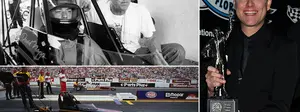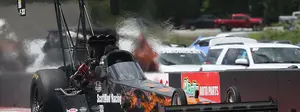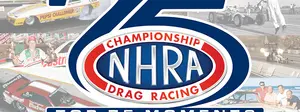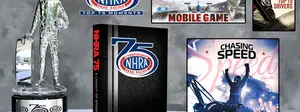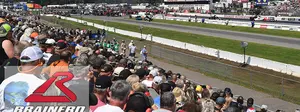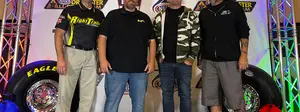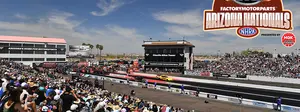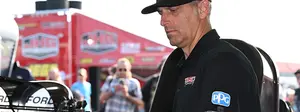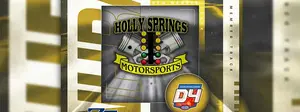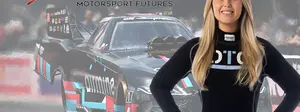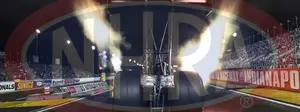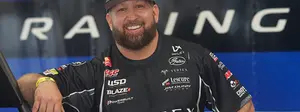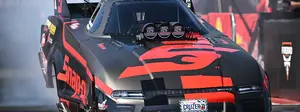

Progress report: Winternationals Pro Stock
Pro Stock enters a new era today with the debut of the new-look entries that no longer have hood scoops and feature big changes under the hood, most notably the addition of electronic fuel injection. In this ongoing feature that will be updated throughout the weekend, we will track how the teams do under the new rules package, providing results, analysis, and more.
Quick links: First qualifying session notes | Second qualifying session notes | Analyzing day one | Third qualifying session notes | Fourth qualifying session notes
PRE-RACE
After a couple of weeks of testing and trying to work out not only engine combinations but also new procedures for burnouts, staging, and launches, the teams will take to the track today for their first official NHRA runs. Here’s what some of the top teams are saying entering today’s first qualifying session.
“All these guys in Pro Stock, including our team, are really smart. You can bet everybody will be trying everything, and we’ll be right there doing it with them.” — Allen Johnson (pictured)
“Every team has been quiet. They aren’t testing their race engines. We won’t know how competitive they are until the first round of qualifying.” — Greg Anderson
“In Florida, we only tested one car, so that gave us the foundation to get everything right on the other cars. This past week, we tested in Phoenix, and we were working on changing small things in the engines. We worked on the cars until the very last minute and just arrived in Pomona this morning.
“It certainly drives differently. I’ll admit it was a little overwhelming at first doing the burnout and taking off the starting line. I’m starting to finally get the hang of it.” — Jason Line
“I’m excited to get the season started, to get a feel for where everybody’s at. We’ve beaten all the changes into the ground talking about them, but it will be interesting to see how it all plays out. It’s definitely going to be a tough year.
“A lot of the teams over the offseason worked on the horsepower they had, but we built two new teams, two new race cars, and a whole new Mopar engine program. We’ve jammed as much as you could pack into an offseason. And with EFI added to the equation with a lower rev limiter and shorter wheelie bars, it’s crazy.” — Erica Enders
“There’s a lot going on in Pro Stock, and a lot of the teams are outside their comfort zone with the new rules. I think it’s exciting to gain new, younger fans with the more production-type finish and appearance of these cars, and the mentality of everyone at Elite is that we are fired up for the massive challenge this year will bring. Like they say, only the strong will survive.” — Jeg Coughlin Jr.
“It took a little time to get used to doing burnouts and completing the staging process properly, but after a few launches, I got the hang of it. It’s a great race car, and I was already very comfortable in the cockpit, so it was just a case of adapting to the new rules.
“We’ve had a chance to make a lot of hits, and we’re running very competitive numbers, so I think we can make a statement right away. They always say the points you earn in these early races count just as much as the ones at the end of the year, and we’d love to get off to a quick start.” — Shane Gray
“Testing went good. Actually, it went better than expected because we hadn’t been down the track besides a few burnouts until we got [to Phoenix]. The car is definitely different to drive with the fuel injection on there, but I can see myself and others taking to it very quickly. It’s just a matter of getting used to it.” — Chris McGaha
FIRST QUALIFYING SESSION
The first session of the new EFI days is in the books, and overall it appears that teams adapted fairly well. There are mixed reports from the pits after the session, in which Bo Butner led with a 6.606 (for reference, last year’s No. 1 time after Q1 was a 6.538 in conditions about 5 degrees cooler, both air and track), but overall, the teams seem pleased with their first runs down the track. The word most frequently heard in the pits after the first session was “conservative.” With a new rules package in place, drivers and crews pretty much unanimously told us they were cautious on their first passes, just hoping to get a full run that could give them a feel for how things are going and a baseline from which they could tune future runs.
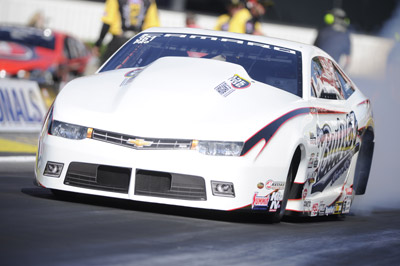
“We thought we would be fast, all three of our cars, and our speeds show we were fast, but then again, we were conservative because we wanted to try to not start [early] in this next session,” said Butner. “We’re very happy, and we have a lot to improve on.
“Jason [Line]’s pretty sad — he wanted to be way fast, but I tried to tell him that was the first run, and we were the top three fastest cars, speed-wise. We were just being conservative for the track. We’ll get after it now.”
One area that has been a focus of discussion is both the burnout and staging processes, which have had to be adjusted for the new engines (you can read more about that with EFI University’s Ben Strader here). Butner acknowledged the challenges in that but also said that area really isn’t a focal point now.
“It’s just hard to control, just learning the whole system on the tune-up, but right now, we’re not even concerned with the staging part; we want to make good, clean runs, then we’ll work on that,” Butner said. “We can stage it at any time, any point, it doesn’t matter. We just need to go make good runs and be fast. We’ll get into race mode tomorrow.”
Reigning world champion Erica Enders also noted there has been a definite adjustment period to the new setups, noting a different feel with the throttle pedal.
“It’s definitely different,” said Enders, who made a full 6.67-second pass but also acknowledged her team was not 100 percent happy with the run. “As far as quick details go, the throw of the throttle pedal is a lot longer than it was on the carburetor, and it’s much easier to push, so we were kind of trying double springs and doing something to make the pedal a little bit stiffer for us to make it feel more like a carburetor pedal, but seat time is really what’s going to make us good at it. Watching everybody do burnouts, myself included, there was a little bit of a struggle in Phoenix, but I think everybody’s got it down. It’s definitely a different procedure in the car as far as burnouts and staging goes.”
Though he acknowledges the new procedures are different and will require some work, Drew Skillman says that was not an issue for him on his first run, which was a little off pace at 7.11.
“Nerves were more of an issue, being the first race of the year and trying to get those initial butterflies out of the way,” he said. “The car was acting great until I put it into high gear, and then it just started going on the rev limiter, and it just stayed on it when it was in gear, which is not supposed to happen. Everything looks fine. We’re checking sensors now.”
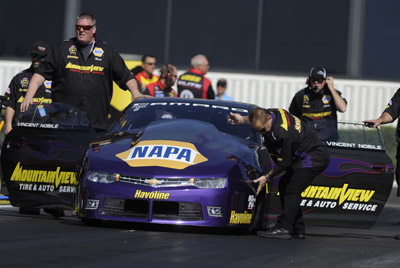
Skillman’s quasi-teammate Vincent Nobile, who also uses Elite Motorsports engines and shares a pit with last year’s Auto Club Road to the Future Award winner, had a strong start to the weekend, though the sheets won’t fully reflect that. When Nobile rolled through the finish line, his time was 6.617, and that initially had him No. 2 in the order, but his fuel failed post-run inspection, so he will enter Q2 with no time.
“Unfortunately, that run isn’t going to count for us, but we did get some good data,” said Nobile. “The car, obviously, went fast, so we’re going to take it from there, I guess. Everything is brand-new, so everyone just wanted to get down the track, so I think next run, you’ll see some more faster runs.”
The final member of the Elite camp, Jeg Coughlin Jr., was happy with his first attempt, which netted him a 6.64 that places him fourth entering Q4.
“It went really well,” said Coughlin, after the pass. “That first run was a little nerve-racking for all of us. It’s a new format for us. We’re out of our comfort zones, but we established pretty good rhythms there in Phoenix. I let the clutch, the car rolled out, it was a little lazy at first, but then it lifted the front end out in that fine Pomona style, and then it started marching on down there. It’s not going to be lightning-fast, but we wanted to go A to B, and we’re going to keep pecking at this thing.”
Coughlin was not only happy with the way the car ran but also his overall experience in the car, noting how much easier it was to stage in the left lane with no hood scoop in the way.
“When you hop into that left lane, not having that great big scoop in front of you just kind of opened up the world, so as a driver, we have very little excuse in that left lane for not hitting the Tree very well,” he said. “[One big visual difference that] is really pleasing to my eyes is the look of the cars — they look fantastic; they really rival their counterpart that comes out of the factory.”
Following is a comparison of the best incremental times during Q1 last year vs. Q1 this year. In regards to weather conditions, the air temp was 7 degrees warmer than last year, the track temp was 4 degrees warmer, and the adjusted altitude was 376 feet higher.
| Pro Stock Q1 incrementals 2015 vs. 2016 | |||||
| 60 feet | 330 feet | 660 feet | 1,000 feet | Quarter-mile | |
| 2015 | .987 | 2.746 | 4.210 | 5.474 | 6.538 |
| 2016 | .987 | 2.766 | 4.250 | 5.529 | 6.606 |
SECOND QUALIFYING SESSION
Though there were some improvements, including Jason Line’s best-of-the-session 6.618 that was five-thousandths quicker than his Q1 run, overall, most drivers ran close to the same time as they did in the first session. Bo Butner, who clocked a 6.62 on his second attempt, stayed No. 1 with his 6.606 from Q1.
“We all joked at the start that whoever is going to win this race will be the guy that can start up and do a burnout and stage every round,” said Butner, with a laugh. “I think there’s a lot more to come. Everybody will slowly get better. I would assume we would run a high .58, .57 if the conditions stay the same and we make perfect runs. None of us have made perfect runs. They’ve definitely made some really good horsepower, you can tell by our speed.”
Following is a comparison of the best incremental times during Q2 last year vs. Q2 this year. In regards to weather conditions, the air temp was 9 degrees warmer than last year, the track temp was 1 degree warmer, and the adjusted altitude was 522 feet higher.
| Pro Stock Q2 incrementals 2015 vs. 2016 | |||||
| 60 feet | 330 feet | 660 feet | 1,000 feet | Quarter-mile | |
| 2015 | .979 | 2.736 | 4.200 | 5.461 | 6.523 |
| 2016 | .993 | 2.773 | 4.259 | 5.540 | 6.618 |
Finally, here is a comparison between the top eight times recorded Friday last year vs. today’s top eight times.
| Pomona Friday quick times 2015 vs. 2016 | |
| 2015 | 2016 |
| 6.523 (Jason Line) | 6.606 (Bo Butner) |
| 6.527 (Drew Skillman) | 6.618 (Line) |
| 6.538 (Greg Anderson) | 6.621 (Butner) |
| 6.538 (Rodger Brogdon) | 6.623 (Line) |
| 6.538 (Chris McGaha) | 6.641 (McGaha) |
| 6.539 (Line) | 6.645 (Jeg Coughlin Jr.) |
| 6.540 (Jonathan Gray) | 6.647 (Anderson) |
| 6.546 (Allen Johnson) | 6.651 (Skillman) |
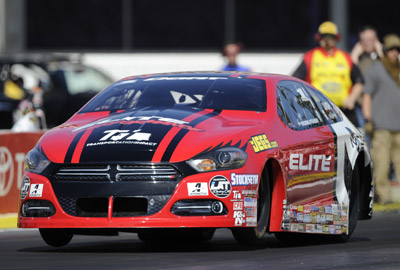
All in all, the first day of EFI, no hood scoops, and a 10,500 rev limiter went well for teams. Though there were some miscues, they seemed to be relatively minor, and the vast majority of teams made at least one full representative run. Drivers were running very close to one another, as has been the norm for many years. There is definitely still room for improvement and growth, but overall, the first day was a success.
Following the day’s two runs, we caught up with EFI University’s Ben Strader and reigning world champion Erica Enders to get a feel for how things went on the opening day and areas to keep an eye on moving forward.
Ben Strader, EFI University
How do you think the class as a whole did today?
I think, obviously, anybody who’s been following can see that they’re down a little bit in e.t. and mph, but that was expected. The 10,500 rev limit definitely affects that, but I think the more surprising point is that the cars are running so close together with such a diverse approach to how things are done. Everybody out here got a pile of parts in September/October, and let’s see what you can come up with. To me, it’s pretty surprising that these guys went out there and are running side by side. There’s no clear runaway victor and no clear like just can’t figure it out. I think that says a lot about Pro Stock and how smart these people are.
Were you surprised we didn’t see any big problems?
Everybody wants to see the train wreck, right? I think there were a few of those, but we didn’t see any major disasters for people. There were a couple of people along the pits that I’ve talked to who’ve said, "Oh gosh, we missed it Q1 and kind of got it back together in Q2," and that’s to be expected. Am I surprised? Well, I see this every day, so probably not, but I think a lot of people were expecting it to be a crash-up derby out there, and we just didn’t give them that. But we are dealing with the smartest people in drag racing, so I don’t know that that should be surprising.
One area of concern has been throttle control, and it did seem that some drivers had some issues there. Did you notice that?
I think there’s a little bit of frustration with some of the drivers there, and you can tell because they go out there and kind of forget, like, "I’m going to put it on the limiter," and they just mash it to the floor and the cards fall where they may. Obviously, the downside to that is being consistent and getting the right spot. I did notice that we are not out of the woods with people struggling with the conversion to EFI, and while the cars are running and making horsepower — that’s not surprising, the engine’s an air pump — but to get it nice and smooth and drivable, it will probably be some time. I mean, there’s plenty of work left for me to do at EFI University, so that’s great, but it will be some time before everybody puts that in their rearview mirror and focuses on how to make their cars faster.
Now that teams do have a couple of runs under their belts, what do you think will be the focus tomorrow and Sunday?
I could be talking out of school, but I think you’re going to see a lot of people playing with gear ratios and differentials and trying to find out where the mph and where the e.t. is and how to get the car to travel better down the first part of the track. The EFI side of things I think everybody, for the next couple of races, you’re going to see them figuring out, "How do we stage? How do we do the burnout?" As Erica says, trying to get back into their groove and do the same thing every time, perfect staging and burnouts. Until other teams figure out what their procedure is, you’re going to see a lot of laptops on top of the car.
Is there anything else we should be watching for?
I think it’s going to be a lot more of the same. People are going to be working on the same stuff tomorrow that we were working on today, and you’ll probably see us in Phoenix working on the same stuff again. I think watch and see.
How long do you think it will take people to really dial things in?
I think time will tell. The people that are open-minded and are willing to adapt to what’s happening are going to catch on faster than people that are adamant about trying to make it like we’ve always had it before and turn their EFI system back into a carburetor. It’s a matter of how long they want to be stubborn. I’m with Erica, like did we shine today? Well heck no, but kind of we did. I mean 11 passes. We had engines last week on Wednesday. I don’t think we have anything to complain about. I think everybody should be scared.
Erica Enders
What was your approach today?
I try to have the same mindset all of the time, and thankfully, we have some very smart people — Ben [Strader] and Jake [Hairston] — who are the ones fooling with the EFI, and then, of course, my crew chiefs that work on the setup. My job is the same, and that’s just to be a driver. As hands-on as I am back here in the pits, my job up there is to do the best burnout I can, back up where I’m supposed to, shallow stage the car, cut a good light, and hit my shifts. That mentality has never changed. I didn’t go into it with a different approach. Of course, that thought is in the back of your mind like, "Holy crap; all this stuff is so different," and I’m in a Dodge Dart, which my visual perspective in the car is different. I’m sitting farther back, the windshield is farther out, the A-pillar blocks the Tree in the right lane, so it’s a lot of differences for me as a driver, but my focus remains the same. I don’t dwell on the negativity. We choose to embrace the changes and work with it, and our focus is to get better.
Grade your two runs today.
I guess I’d give us a B if I had to give us a grade. I mean, A for effort for sure. There is definitely a lot of lack of sleep around this Elite Motorsports camp, including the engine guys at Elite Performance who literally finished putting together our Mopar stuff at Phoenix on Wednesday. I mean, you talk about sliding in right under the wire, and that gives us a lot of optimism heading into the rest of the year because we built this Mopar engine program in a very short time with no R&D. I think the sky is the limit, and we can only go up from here. Having said that, today went OK. We didn’t make good runs at all. Our runs sucked, to be frank. We all know that. It’s nobody’s fault. We don’t point fingers here. We’ve just got to go up tomorrow with a better setup. We’re still getting used to it. I have 11 runs on that race car. That’s a brand-new Rick Jones chassis, so they’re learning the car, we’re learning EFI, and I’m learning how to drive the dang thing, so we’re heading in a great direction. I’m in a really good mood today. I think that after testing I was a little down on myself because I wasn’t perfect in the cockpit, but it’s just going to take some time to get used to, and I need to cut myself a little slack, but that’s not my personality at all. But we did good. My guys did a great job. They have worked so hard. Richard [Freeman] has spent so much money, and there’s so much time these people have spent away from their families to work on this. We’re excited for what’s to come.
The Pro Stock teams continued to do well in the new configuration, and we saw several teams improve, including with the first 6.5s in the EFI era. Greg Anderson earned the distinction of being the first in the 6.5-second zone when he powered to a 6.586 that held on for the No. 1 spot entering the final session later today. Anderson’s teammate, Jason Line, was the only other driver to run in the 6.5s, posting a 6.592. Friday’s top driver, Bo Butner, who also uses KB powerplants, slipped to No. 3 after recording a 6.609 that was just .003-second slower than his pass yesterday. Also of note, the session produced the first speeds to exceed 210 mph. Line and Butner posted matching speeds of 210.14 mph in the final pair.
Following is a comparison of the best incremental times during Q3 last year vs. Q3 this year. In regards to weather conditions, the air temp was 5 degrees warmer than last year, the track temp was 15 degrees warmer, and the adjusted altitude was 338 feet higher.
| Pro Stock Q3 incrementals 2015 vs. 2016 | |||||
| 60 feet | 330 feet | 660 feet | 1,000 feet | Quarter-mile | |
| 2015 | .979 | 2.742 | 4.201 | 5.457 | 6.516 |
| 2016 | .984 | 2.759 | 4.239 | 5.513 | 6.586 |
The final session produced somewhat mixed results. On the positive side, the KB team continued to march. Greg Anderson improved his No. 1 time by .001-second, and Jason Line, who stayed No. 2, upped the best speed to 210.34 mph. Fellow KB runner Bo Butner joined the 6.5-second club with a 6.594 that has him third in the order.
Though those three continued to perform well, we did see some miscues from others. At this point, the exact cause of some of those troubles is unclear, but Shane Gray, Allen Johnson, and Vincent Nobile all had issues at varying points of their runs. Gray had issues with his burnout, trying it twice and unsuccessfully performing the standard full burnout that goes across the starting line. Gray pulled up after the short burnout, staged, and made a full 6.68 pass. Johnson’s problems came when he slowed at the top end, posting a 6.76 at just 185 mph. Nobile, meanwhile, had issues after his burnout when his car temporarily could not get into reverse. He eventually got the car to back up and made his run, which came in at 6.62 seconds.
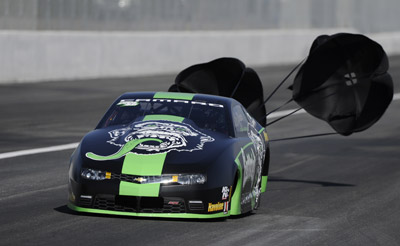
Another driver who appeared to have slight problems in the fourth session was Alex Laughlin, whose car drifted a bit toward the centerline, slowing him from his earlier pass by about three-hundredths. Though his final run wasn’t the improved pass he wanted, Laughlin did end the day in the No. 7 spot, the first top-half start of his young career. Laughlin and his group seem to have adapted fairly quickly to the new configuration, putting up strong numbers in testing and making steady improvements here. When we talked with Laughlin after his 6.63 earlier today, he acknowledged that perhaps his lack of experience in the class, which also means he doesn’t have certain habits ingrained in his brain and instincts, could be a factor in that.
“I’m not just stuck with one way with this. Now I can react when something happens or just the pedal and how it feels, just get used to it easier and better than somebody who has it ingrained in their brain,” said Laughlin. “I’m actually thrilled that all these changes happened when they did, so I got to learn the car as they knew it, and then now relearn it with these guys who have been racing this class longer than I’ve even been alive. It’s definitely a different playing field, and having driven so many different things in different auto sports and whatnot, it applies to be being able to adapt to this. This thing is so much different than everything else, but once you do a lot of different things, you can slow everything down. Even though it’s happening so fast, you can slow it down and process what you’re doing and react to things in a better way than some people who may have been doing it forever. You can see that some of the best-known veterans out there are having some struggle with this, and we’re just plugging right along and making progress.”

























